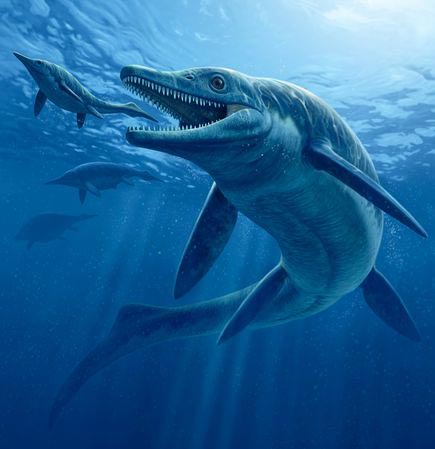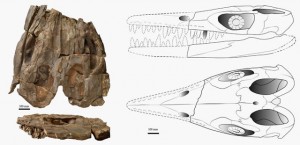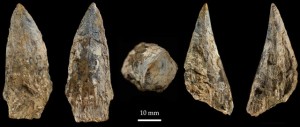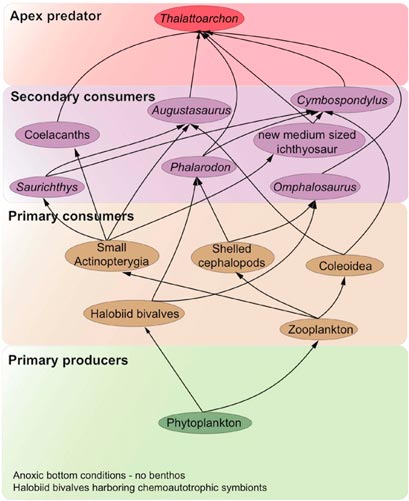Lizard-Eating Sovereign of the Sea – Thalattoarchon saurophagis
Discovered back in the late 1990s and finally collected in 2010 but with a scientific description just published; the ichthyosaur family of marine reptiles has a new member. It might have been appropriate to describe a number of ichthyosaur genera as dolphin-like but this newly erected genus has a closer affinity to the likes of the Orca (Killer Whale) in terms of where it would have been placed on the food chain. The newly described Thalattoarchon saurophagis (the name means lizard eating sovereign of the sea), would have been an apex predator in the tropical MiddleTriassic sea that this prehistoric monster swam in.
Thalattoarchon saurophagis
The fossils were found in Triassic aged deposits (approximately 244 million years old) from the Favret Canyon region in the arid Augusta Mountains in the state of Nevada (western United States). Much of Nevada today may be covered by dry scrub and desert but back in the Early Triassic this part of North America formed the eastern part of the vast Panthallassic ocean that covered most of the western hemisphere. Within just eight million years or so of the Permian mass extinction event that may have wiped out as much as ninety-five percent of all life in the seas, it seems that marine environments and ecosystems had recovered sufficiently to permit the evolution of what is termed a “macro-predator”, a predator of other large creatures. The discovery of these ichthyosaur fossils not only has important implications for the understanding of ichthyosaur evolution but perhaps more importantly, it suggests that marine ecosystems may have recovered more quickly from the Permian mass extinction than terrestrial ecosystems.
Fearsome Triassic Predator Thalattoarchon saurophagis
Picture credit: Raul Martin/National Geographic
One Individual Specimen
The fossils representing one individual specimen have been found to date, amongst strata that is rich in vertebrate fossil remains including several types of ichthyosaur. The fossils of this predatory reptile include part of the back of the skull and the rear most portion of the jaws, much of the vertebrae, many of which were in articulation with each other, parts of the hips and some of the bones from the rear fins. Using this material and comparisons with other better-known Triassic ichthyosaurs, the research team have estimated that this ichthyosaur may have reached over eight and a half metres in length. Interestingly, living alongside Thalattoarchon was another, perhaps even bigger ichthyosaur – Cymbospondylus which may have reached lengths of ten metres or more.
Fossils of T. saurophagis (Top predator)
Picture credit: Fröbisch et al
The picture above shows the top of the skull (dorsal view) with a side view of the fossil material (lateral view).
The teeth of Cymbospondylus are typical of many other ichthyosaurs, the are conical and pointed, ideal for grabbing slippery prey such as cephalopds and fish. In contrast, the teeth of T. saurophagis are very different. The teeth are proportionately larger, some are up to 7 centimetres in length and they are wider with anterior and posterior cutting edges. The teeth are very blade like, and resemble the teeth of terrestrial theropod predators such as the allosaurids, although they do lack any serrations along the cutting edges (denticles). These teeth are those of a macro-predator, an animal that specialised in catching, killing and eating other marine reptiles.
Along with Cymbospondylus, the shallow sea that would have covered much of the western United States was home to a genus of much smaller ichthyosaur known as Phalarodon. It has been speculated that T. saurophagis hunted these smaller ichthyosaurs.
For models and figures of ichthyosaurs and other marine reptiles: Wild Safari Prehistoric World Figures.
Blade-like Teeth of this Frightening Ichthyosaur
Picture credit: Fröbisch et al
Similar to Cymbospondylus
Thalattoarchon may have resembled Cymbospondylus in having a long, streamlined body ending in a flexible tail with a rudimentary caudal fin but the head is much bigger when compared to the body proportions of the known fossil material of Cymbospondylus. The head of Thalattoarchon is approximately twice the size of the head of Cymbospondylus in relation to the rest of the animal’s body. The scientists responsible for the study including Dr Nadia Fröbisch of the Museum für Naturkunde (Berlin, Germany), have been able to create a model of the food chain that existed in this part of the Panthallassic ocean, placing Thalattoarchon in the apex position, at the top of the food chain.
A Model of the Mid Triassic Marine Ecosystem (Food Chain)
Picture credit: PNAS
The paper detailing the research carried out on these ichthyosaur fossils and the scientific description has been published in the academic journal “The Proceedings of the National Academy of Sciences”.









Leave A Comment